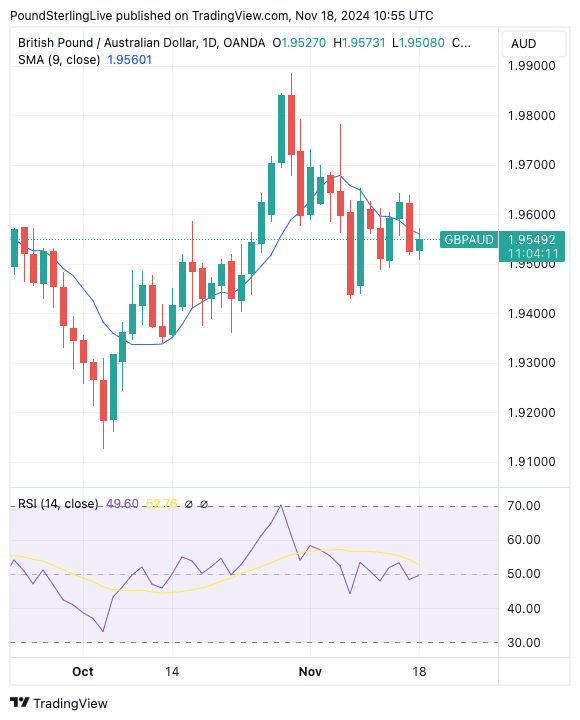Pound to Australian Dollar Week Ahead Forecast: Favouring Some Downside
- Written by: Gary Howes

Image © Adobe Images
The Pound and Australian Dollar are evenly matched, but we could see the Aussie eke out some gains this week.
The Pound to Australian Dollar exchange rate (GBP/AUD) has seen the range it trades shrink as November progresses, which is quite remarkable given the excitement on global markets stemming from the U.S. election.
A fading range in GBP/AUD implies markets see two evenly matched currencies, given the current global dynamics and interest rate expectations.
Note the RSI in the lower panel in the above chart: it is flattening out around the 50 level, which implies that the sideways trend should be preferred.
However, we do note that the pair is also capped by the nine-day moving average, which can indicate that the next few days could see further softness.
When pressed for a directional call, we think the downside of the recent range would be tested before the top side.
As such, 1.95 is an initial target.
Compare GBP to AUD Exchange Rates
Find out how much you could save on your pound to Australian dollar transfer
Potential saving vs high street banks:
A$48.75
Free • No obligation • Takes 2 minutes
The Aussie Dollar was an initial beneficiary of the Trump trade as global equity markets surged on expectations for further U.S. growth outperformance.
But, the reaction function soon evolved to one where AUD came under pressure as markets saw potential vulnerabilities linked to Trump's desire to enact tariffs on China, whose economy Australia is closely aligned.
So we are seeing some mixed signals on the Aussie Dollar, and we think it can recover some recently lost ground if markets opt for a wait-and-see approach regarding Trump and his agenda.
Last week, Trump announced some 'hawkish' names to key leadership roles in his cabinet, including individuals highly critical of China.
"Concerns over trade issues between Washington and Beijing are likely to keep the AUD on offer as well," says Roberto Mialich, FX Strategist at UniCredit Bank.
There is some talk in the analyst community of the initial 'Trump trade' reaching its limits, which could see currencies that fell in the wake of the election recover.
"To the extent that 2016 price action becomes a more dominant FX market template from here, we can conclude that many Trump-related positives are already in the price of the USD," says Valentin Marinov, Head of G10 FX Strategy at Crédit Agricole.
Should this be the case, both AUD/USD and GBP/USD can recover.
For GBP/AUD, what matters is which of these currencies recovers most.
UK Inflation, PMIs This Week's Source of Interest
Regarding event risk, UK inflation data is due for release on Wednesday.
UK inflation is expected to have risen to 2.2% year-on-year in October from 1.7% in September, indicating an acceleration in inflation.
Economists at the Bank of England and the Office for Budget Responsibility recently upgraded their forecasts for the near term in the wake of the October budget, which saw the government announce a big increase in spending.
Also, household energy prices are rising again, so the easy part of the 2024 deflationary process is now behind us.
Core inflation is expected to remain at a sticky 3.2%, driven by strong services inflation. If these figures come in weaker, the pound could come under pressure, as this would open the door to a potential Bank of England interest rate cut in December.
"The services rate is set to remain hovering close to 5% y/y. A significant downside surprise would be needed to meaningfully boost the likelihood of a December rate cut," says Sam Hill, Head of Market Insights at Lloyds Bank.
Should inflation beat expectations, the Pound-Australian Dollar exchange rate could well rally back to its recent highs as investors reinforce expectations that the Bank of England will only be able to cut at a quarterly pace in 2025, meaning just four further rate cuts are likely.
We are particularly interested in the UK's PMI data, due on Friday, as they should incorporate the fallout from the October budget.
There are reports that business sentiment and hiring intentions took a hit following the budget, and this could be reflected in a poor PMI reading. If this is the case, GBP/AUD could close in the red for the second consecutive week.
"In the two weeks since the budget, various big names in the UK retail and hospitality sector have warned that Reeve’s hike to employers’ national insurance contributions would led to a jump of costs to consumers. Others have indicated that it could lead to job losses," says Jane Foley, Senior FX Strategist at Rabobank.
The Bank of England could well respond to signs of a slowing economy by cutting interest rates again next month, judging that it can cut rates further without stoking inflation. It would suggest that the Bank thinks that if growth is allowed to collapse, then inflation would drastically undershoot current expectations in 2025-2026.
Any signs that it will accelerate the rate cutting process would weigh on the Pound.






